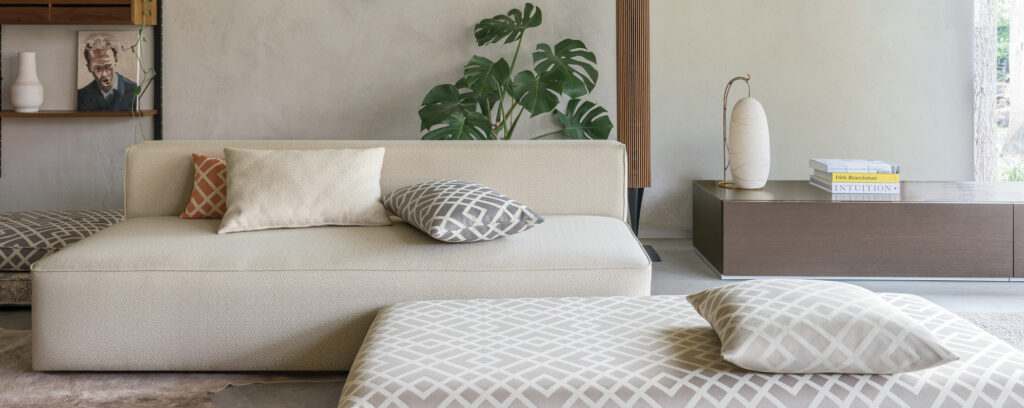This is Japandi (A mash-up of elegant Japanese minimalism and rustic Scandinavian simplicity)
Practical, thoughtful solutions are key to establishing a minimalist look-and-feel in an interior space. Combining a traditional Japanese style with Scandinavian décor creates a clutter-free and functional living space that’s the key to a clear mind.
- Georgina Horspool, Lighting Designer at Alexander Joseph
With a focus on clean lines, solid artisanship and elegant simplicity, Japandi décor is centred on the creation of spaces that are calmingly minimalist and harmoniously beautiful.

Maximising access to light sources and natural daylight in an interior space is an aspect of Scandinavian design that shines brightly in the hybrid style of Japanese minimalism.

That bright Scandi colour scheme, with a twist
Light is always important in interior decorating, and it’s top of the list for Scandinavian design. This is probably because for Scandinavians at least, natural daylight is a hard thing to come by during the long, dark winter months. This is one of the reasons Scandinavian interiors are so defined by white colour schemes: it’s to make spaces feel larger, brighter.
Related read: Our Guide to...Decorating with Neutrals >
Maximising access to light sources and natural daylight in an interior space is an aspect of Scandinavian design that shines brightly in the hybrid style of Japanese minimalism.
That being said though, the first thing you notice about Japandi style is that there isn’t quite as much stark white in it as there would be in an interior space that is strictly Scandinavian.
Instead, the Japandi style is based on a muted colour palette of dusky greys, pale blues and soft pinks blending among richer, earthy shades that you simply can’t find in purely minimalist décor.
This colour palette gives interiors a warm, rustic feel straight from the get-go.
Related read: Why modern glam is the ultimate 2020 decor trend >


Japan and Norway share aesthetics and cultural ideas when it comes to design
There is a simplicity inherent in Scandinavian design that is also obvious in Japanese décor. Clean lines mix with well-designed, functional pieces, organic materials, and colour palettes to create a back-to-basics atmosphere.
Over decoration is a no-no here: neither Japan nor Scandinavia are famous for their maximalist interior stylings. This means that a designer should always be subtracting from a finished space, always removing the unnecessary.
Related read: Designing wabi-sabi hospitality spaces with smooth materials


The interior styling that insists you make do with what you have
Another interesting facet of Japanese minimalism is that it looks at the reuse of materials just as much as it looks at the durability of design.
This is because, in recent years, the ability to tamper with objects or mend them has largely disappeared. It seems that now only specialists can repair devices, furniture, or even clothing.
Related read: Style Spotlight: 4 Secrets of Beautifully ‘Lagom’ Spaces >
In Japan, though, there is a long-standing tradition of mending what is broken, or reforming new pieces from discarded, damaged parts. The ability to make something new out of old parts is an aspect of Japandi styling that is distinctively Japanese.
It’s pretty interesting to note as well that the art of kintsugi is gaining in popularity, coincidentally (or not) at the same time as this hybrid fusion of interior décor styles.


Playfulness and a cosy hominess are both allowed with Japandi styling
Pairing nicely with the rustic colour schemes, there is an organic, handmade feel to Scandi-Japanese décor that isn’t found when you separate Scandinavian and Japanese design out into their pure forms.
It’s fun to see hygge (the Scandinavian focus on homely cosiness) and wabi-sabi (a Japanese notion of finding beauty in imperfection) blending and joining forces in Japandi interiors. This emphasis on cosy hominess, however, does not mean ‘clutter’. This probably sounds like a downer if you’re a borderline hoarder (we know you’re out there), but honestly, it’s still OK to play! For example, where Japandi interiors really break out is by playing with texture and tone.
Related read: The ultimate guide to staying in >
As in Japan, most Scandinavians aren’t that big on wall-to-wall carpets. Interior designers in both cultures prefer to work with materials like light or dark woods, or stone, in their flooring. Natural fibres such as hemp and wool are everywhere in Japandi design.
Natural finishes, rough edges and organic shapes all help designers evoke a simple, almost naïve feel in an interior space without having to make a splashy statement.


FibreGuard's easy clean upholstery is perfect for Nordic interiors that have a Japanese feel
FibreGuard's upholstery fabrics are perfect for Japandi style interiors due to their unique combination of durability, functionality, and aesthetic appeal. They're available in a wide range of neutral and earthy tones that seamlessly integrate with Japandi aesthetics.
On top of all this, our upholstery is carefully designed to withstand everyday wear and tear while still maintaining a sophisticated and understated look. They're perfect for even the busiest design-conscious household.
Whether it's the neutral colour palette, eco-friendly responsible design practices, or stain-resistant technology, FibreGuard's fabrics are an excellent choice for those seeking to create a Japandi-inspired living space.
How do you feel about this latest offshoot of minimalist interior décor? Come on over to our Instagram and join in the conversation!